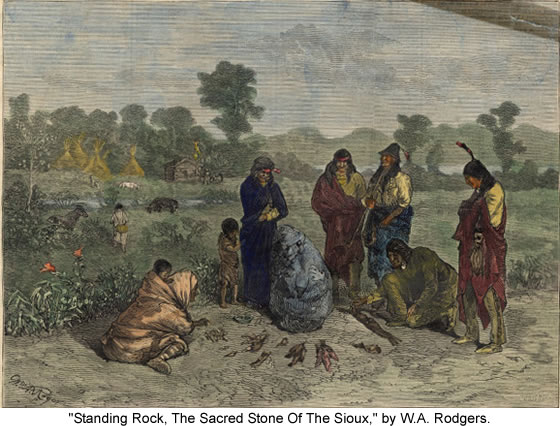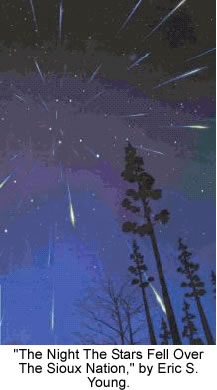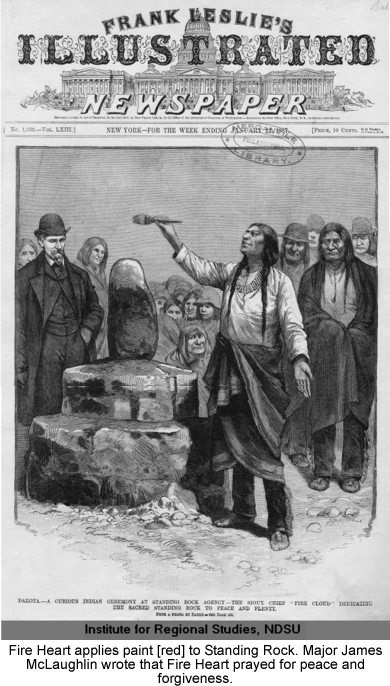 |
Canku Ota
|
 |
|
(Many Paths)
|
||
|
An Online Newsletter
Celebrating Native America
|
||
|
January
2014 - Volume 12 Number 1
|
||
|
|
||
|
Standing Rock Legend,
A Test Of Faithfulness
|
||
|
by Dakota Wind
|
||
|
Another Legend
Of Standing Rock
STANDING ROCK, N.D. – There are several variations of the story of Standing Rock, but all of them end with a woman transforming into stone. On the Northern Plains there are three tribes which have a Standing Rock story: the Cheyenne, the Arikara, and the Standing Rock Sioux. There is a different location associated with each story too. The story of Standing Rock, in a way, mirrors the story of the horses' arrival. There are several variations of the story of first contact with horses, and in different places too. The common element of the horse story is awe and a renewed sense of respect for the mystery of creation. No one story is right, and no one location is the exact one. The stories of Standing Rock always end in the transformation of a woman into stone. Perhaps some long ago event about a woman who was universally beloved by the tribes of the Northern Plains inspired stories associated with all the feelings and angst of love and tragedy. One variant tells of the importance of obeying the supernatural, another of patience and waiting for a lost love to return, and here's yet another version about infidelity. It was collected by Colonel Welsh in Fort Yates, on the Standing Rock Sioux Indian Reservation in 1915. A previous version from Welch's notes from the website Welch's Dakota Papers was featured here, but this version was tucked away in the AB Welch collection at the North Dakota State Archives. The date of this variant places the incident in 1833 along the Grand River on the Standing Rock Sioux Indian Reservation, while the Yanktonai Dakota version places the tale in 1740 near Cannonball River, also on the Standing Rock Sioux Indian Reservation.
The young man, soon after, went away on an expedition against the Crows. He and his party were gone all summer and in the fall were caught by the early winter on the Yellowstone River and owing to the large body of captured horses the party was compelled to make winter camp. As early as they could move in the spring they started across the country and finally arrived at the village of their tribe. There was great rejoicing, dancing and feasts. The young man then went to the sundance and distinguished himself by dragging bison skulls, and prayed to become a great leader among his people. The young man was eventually selected as chieftan over a small band. For some reason, the suspicions of the young chief were aroused against his wife and she was compelled to consume a draught of bitter herbs, as a test. If she were innocent, it was believed that the herbs would have no effect upon her. If she were guilty, the drink would make her sick. She became violently ill and it was decided that she had been unfaithful. Accordingly, a procession was formed and she was taken upon the hill that stands alone. In the presence of the entire tribe, the young chief pronounced a terrible curse upon her. The medicine men performed a mystical rite and the winds rushed and roared, rain and hail beat down with great fury, the sun became darkened – it was midday -, fire leapt out of the ground, and spirits were seen rushing through the air.
At this demonstration, the tribe, in great fear, fell down upon the ground, and when the terrible things had ceased, they looked, and beheld the young woman with a babe upon her back had turned to black stone. This stone thereafter was greatly regarded as sacred. |
|
|
||
|
|
||
| Canku Ota is a free Newsletter celebrating Native America, its traditions and accomplishments . We do not provide subscriber or visitor names to anyone. Some articles presented in Canku Ota may contain copyright material. We have received appropriate permissions for republishing any articles. Material appearing here is distributed without profit or monetary gain to those who have expressed an interest. This is in accordance with Title 17 U.S.C. Section 107. | ||
|
Canku Ota is a copyright ©
2000 - 2013 of Vicki Williams Barry and Paul Barry.
|
||
 |
 |
|
|
The "Canku
Ota - A Newsletter Celebrating Native America" web site and
its design is the
|
||
|
Copyright ©
1999 - 2013 of Paul C. Barry.
|
||
|
All Rights Reserved.
|
||

 A
long time ago, the year the stars fell [1833], a young warrior took
many presents, and laid them at the lodge of a family where a beautiful
maiden lived. The father of the maiden came out, looked at the piles
of valuable furs and beautiful ornaments, saw the slick slim limbed
ponies, and his heart was soft within him. He gathered up the presents,
carried them into his tipi, when he came out, he lead his daughter
by the hand and presented her to this young warrior for his wife.
A
long time ago, the year the stars fell [1833], a young warrior took
many presents, and laid them at the lodge of a family where a beautiful
maiden lived. The father of the maiden came out, looked at the piles
of valuable furs and beautiful ornaments, saw the slick slim limbed
ponies, and his heart was soft within him. He gathered up the presents,
carried them into his tipi, when he came out, he lead his daughter
by the hand and presented her to this young warrior for his wife.
